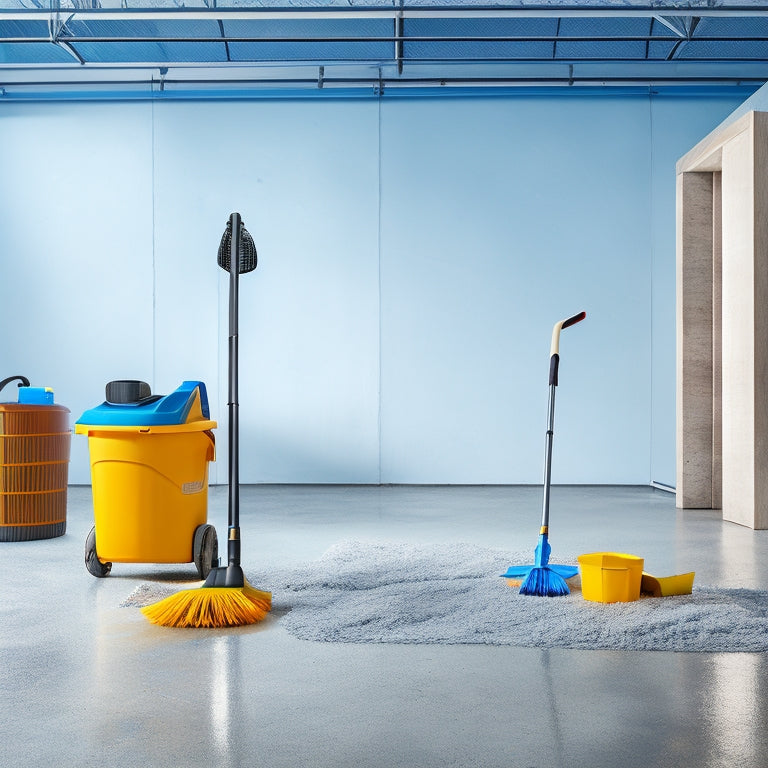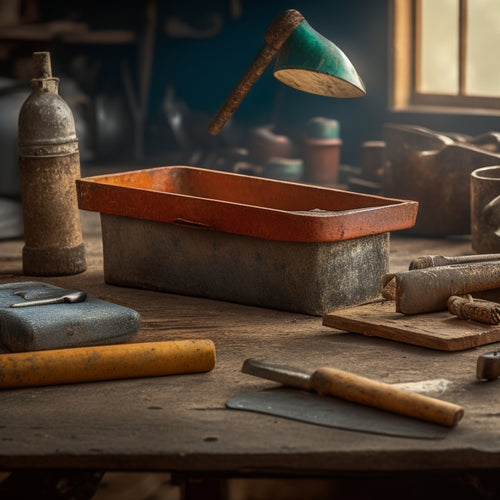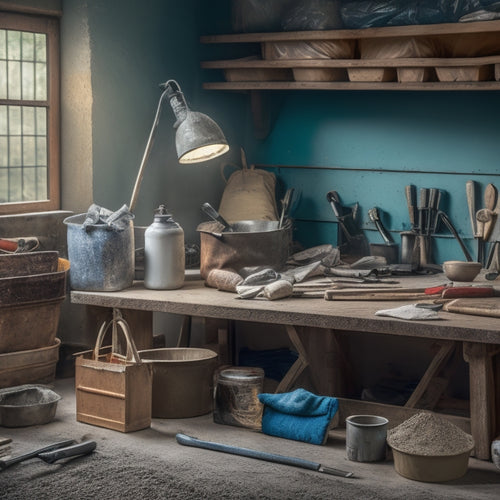
What Tools Do You Need for Concrete Floor Cleaning
Share
You'll need an extensive arsenal of specialized tools to effectively clean and maintain concrete floors. Essential cleaning solutions, like eco-friendly options and natural ingredients, are a must. Brushes for aggressive scrubbing, concrete floor edging tools, and pressure washing equipment are also necessary. Additionally, floor scraping and grinding tools, dust containment systems, and cleaning path clearance tools will come in handy. Don't forget protective gear and accessories, such as steel-toed boots, chemical-resistant gloves, and safety goggles. With these tools, you'll be well-equipped to tackle even the toughest concrete floor cleaning tasks, and exploring the specifics of each will reveal more insights into the trade.
Key Takeaways
• Essential cleaning solutions include eco-friendly products, natural ingredients, and DIY alternatives like baking soda and vinegar for effective dirt removal.
• Brushes and edging tools are necessary for aggressive scrubbing and cleaning tight spaces, with durable materials like nylon and steel providing effective results.
• Pressure washing equipment, including electric and gas pressure washers, is crucial for heavily soiled areas, with factors like PSI, GPM, and nozzle type to consider.
• Floor scraping and grinding tools, such as scrapers and dustless grinding machines, are required for removing stubborn dirt and residue, with protective gear essential for safety.
• Protective gear and accessories, including steel-toed boots, chemical-resistant gloves, and safety goggles, are vital for injury prevention and a safe cleaning operation.
Essential Cleaning Solution Tools
You'll need a reliable arsenal of essential cleaning solution tools to effectively tackle dirt, grime, and stubborn stains on your concrete floor.
When it comes to selecting the right cleaning solutions, it's vital to prioritize eco-friendly options that are gentle on the environment yet tough on dirt. Look for products that are free from harsh chemicals and toxins, and instead opt for natural ingredients that are biodegradable and non-corrosive.
In addition to eco-friendly solutions, consider cost-effective alternatives that can help you save money without compromising on cleaning power. For instance, you can create your own cleaning solution using a mixture of baking soda and vinegar, which isn't only environmentally friendly but also budget-friendly.
Another option is to use microfiber cleaning pads, which can pick up dirt and grime easily without the need for harsh chemicals.
Brushes for Aggressive Scrubbing
Scrubbing away stubborn stains and grout lines with the right brushes becomes an essential step in concrete floor cleaning, as it requires a level of aggression that gentle sweeping or mopping can't match.
When it comes to aggressive scrubbing, you'll need brushes that can withstand the force and friction involved. Look for brushes made from durable materials such as nylon, polypropylene, or natural fibers like coconut or palmyra. These materials can handle the rigors of scrubbing techniques that involve applying pressure and using back-and-forth motions to dislodge dirt and grime.
The type of brush material you choose will also depend on the type of stain or grout you're dealing with. For example, nylon brushes are effective against oil-based stains, while polypropylene brushes work well on water-based stains. Natural fiber brushes, on the other hand, are gentler on the floor but still effective against tough grout lines.
When using these brushes, make sure to wear protective gear like gloves and safety goggles to avoid injury. With the right brush and scrubbing technique, you'll be able to remove even the toughest stains and leave your concrete floor looking like new.
Pressure Washer Options
Frequently, when tackling heavily soiled or large concrete floors, pressure washers become an indispensable tool for efficient and effective cleaning.
You'll need to decide between electric pressure and gas pressure washers, each with its own advantages. Electric pressure washers are ideal for smaller areas, providing a quieter and more eco-friendly cleaning experience. They're also generally lighter and more portable. Gas pressure washers, on the other hand, are more powerful and suitable for larger areas, but they're noisier and produce emissions.
When choosing a pressure washer, consider the following key factors:
-
PSI (Pounds per Square Inch): Look for a pressure washer with a high PSI rating (at least 1500) to effectively remove dirt and grime.
-
GPM (Gallons per Minute): A higher GPM rating guarantees faster cleaning, but be mindful of water consumption and potential environmental impact.
-
Nozzle type: A wide fan tip nozzle is ideal for concrete floors, as it provides a wider cleaning path and reduces the risk of damaging the surface.
Remember to always follow safety guidelines when operating a pressure washer, including wearing protective gear and maintaining a safe distance from the spray nozzle.
Effective Floor Scraping Tools
After pressure washing, turn to effective floor scraping tools to remove stubborn dirt, old coatings, and other residue that can hinder the cleaning process or compromise the floor's finish.
You'll need a scraper that's designed for concrete floors, with a sturdy handle and a replaceable blade. Choose a scraper with a curved or angled blade for better leverage and control.
When scraping, always wear protective gear, including gloves, safety glasses, and a dust mask. Use proper scraping techniques, such as applying gentle to moderate pressure and making slow, even strokes. This will help prevent scratching the floor or creating uneven surfaces.
For more aggressive scraping, consider using a walk-behind or ride-on scraper. These machines are designed for heavy-duty floor maintenance and can save you time and effort. However, be sure to follow the manufacturer's instructions and take necessary safety precautions to avoid accidents.
Concrete Floor Edging Tools
You'll need a concrete floor edging tool to remove dirt and debris from tight spaces, such as corners, baseboards, and around obstructions, where larger cleaning equipment can't reach. This is an essential step in concrete floor cleaning, as it guarantees a thorough and even clean.
When choosing an edging tool, consider the materials and design. For example:
-
Steel edgers are durable and effective for removing heavy dirt and grime buildup.
-
Plastic or nylon edgers are better suited for smaller areas and more delicate surfaces, reducing the risk of scratches.
-
Adjustable edgers allow for customized angles and widths, making them ideal for maneuvering through complex spaces and obstructions.
Remember to always follow proper concrete edging techniques to avoid damaging the floor or the tool. Wear protective gear, such as gloves and safety glasses, to prevent injury.
Dustless Floor Grinding Machines
When you're looking for a dustless floor grinding machine, you'll find that there are several types to choose from, each with its own strengths and weaknesses.
You'll need to take into account factors like the grinding head options, which can range from diamond-impregnated segments to carbide-tipped designs.
Machine Types Available
Your concrete floor cleaning arsenal should include dustless floor grinding machines, which come in various types, including walk-behind, ride-on, and remote-controlled models. These machines are designed to efficiently remove dirt, grime, and old coatings from your concrete floors while minimizing dust and debris.
When selecting a dustless floor grinding machine, consider the size of your floor, the level of traffic, and the type of cleaning task at hand.
-
Walk-behind models are ideal for smaller areas and provide greater maneuverability, making them perfect for tight spaces and corners.
-
Ride-on models are designed for larger areas and offer increased productivity, reducing fatigue and improving efficiency.
-
Remote-controlled models provide enhanced safety and flexibility, allowing you to operate the machine from a safe distance.
Proper machine maintenance is essential to guarantee the longevity of your equipment and maximum performance. Regularly check and replace worn-out parts, clean the machine thoroughly, and perform routine maintenance tasks as recommended by the manufacturer.
Grinding Head Options
With the right dustless floor grinding machine selected and properly maintained, it's time to focus on the grinding head options that will help you achieve the desired level of floor cleanliness and finish. The grinding head is a vital component that comes into direct contact with the concrete floor, and choosing the right one is essential for effective cleaning.
When selecting a grinding head, you'll need to take into account the grinding head materials and sizes. Here are some common options:
| Grinding Head Material | Grinding Head Size | Recommended Use |
|---|---|---|
| Diamond | 10-12 inches | Heavy-duty grinding and removal of old coatings |
| Carbide | 6-8 inches | Medium-duty grinding and polishing |
| Ceramic | 4-6 inches | Light-duty grinding and maintenance |
| Steel | 8-10 inches | Aggressive grinding and removal of thick coatings |
Based on your specific cleaning needs, you may need to experiment with different grinding head materials and sizes to find the perfect combination. Remember to always follow safety guidelines when operating a dustless floor grinding machine, and verify the grinding head is properly attached and secured to avoid accidents.
Dust Containment Systems
As you prepare to tackle concrete floor cleaning, you'll need to evaluate the significance of dust containment systems. Most dustless floor grinding machines come equipped with built-in dust containment systems that utilize high-efficiency filters and powerful vacuum motors to capture up to 99% of dust and debris generated during the grinding process.
These systems are essential for maintaining a safe and healthy work environment. Without them, you'd be exposed to harmful dust particles that can cause respiratory issues and other health problems.
Here are some key features to look for in a dust containment system:
-
Advanced filtration systems: Look for machines with HEPA filters or similar technology that can capture 99.97% of particles as small as 0.3 microns.
-
Sealed cabinets and doors: Verify that the machine's cabinet and doors are tightly sealed to prevent dust from escaping.
-
Dust containment materials: Opt for machines that use durable, dust-resistant materials to minimize the risk of dust leakage.
Concrete Sealer Applicator Tools
You'll need a high-quality concrete sealer applicator tool to guarantee a uniform, even coat on your floor. When selecting a tool, consider the type of concrete sealer you're working with, as different sealers require specific application techniques.
For instance, acrylic and polyurethane sealers are best applied with a lambswool applicator or a microfiber mop, while epoxy and polyurea sealers require a notched squeegee or a specialized epoxy applicator.
Choose a tool that allows for even distribution and coverage, ensuring a smooth, consistent finish. Look for tools with adjustable handles and heads to accommodate different floor sizes and shapes.
Additionally, consider the tool's material and construction, opting for durable, chemical-resistant materials that can withstand the sealer's solvents. Safety should also be a top priority, so select tools with ergonomic grips and balanced designs to reduce fatigue and prevent accidents.
Cleaning Path Clearance Tools
When you're preparing to clean a concrete floor, you'll need to clear the path of debris and obstacles to guarantee a smooth and efficient cleaning process.
You'll want to gather the right tools to remove dirt, dust, and other substances that can interfere with your cleaning solution or equipment.
Debris Removal Essentials
Three essential tools are required to clear the cleaning path of debris, ensuring a safe and efficient concrete floor cleaning process. You'll need these tools to effectively remove debris and prevent damage to your cleaning equipment or injuries to yourself.
To start, you'll need:
-
A broom or dust mop to sweep away loose debris, such as dust, dirt, and small rocks.
-
A debris collection tool, like a dustpan or a small shovel, to gather and dispose of debris.
-
An outdoor debris management system, such as a trash can or dumpster, to contain and manage debris collection methods.
Clearing Tight Spaces
To effectively clear tight spaces, such as corners, crevices, and edges, where debris often accumulates and obstructs your cleaning path, utilize specialized cleaning path clearance tools. These tools are designed to navigate tight space techniques, allowing you to reach areas that traditional cleaning equipment can't.
When maneuvering equipment in tight spaces, it's crucial to prioritize safety. Look for tools with ergonomic handles, adjustable extension wands, and precision nozzles that can be angled to reach tight spaces without putting you at risk.
Some popular cleaning path clearance tools include crevice tools, edge cleaners, and detail brushes. Crevice tools are long, thin nozzles that can be inserted into tight spaces to dislodge debris. Edge cleaners are designed to clean along baseboards and corners, while detail brushes are used to sweep away dust and dirt from tight spaces.
Protective Gear and Accessories
You'll need to gear up with the right protective equipment and accessories to guarantee a safe and efficient concrete floor cleaning process. Safety protocols are essential to prevent injuries and assure a successful cleaning operation. As you prepare for the task, remember that protective clothing is a must-have.
Here are some essential protective gear and accessories to include in your arsenal:
-
Steel-toed boots: Protect your feet from heavy equipment, sharp objects, and harsh cleaning chemicals.
-
Chemical-resistant gloves: Prevent skin irritation and damage from harsh cleaning agents and abrasive materials.
-
Safety goggles: Shield your eyes from flying debris, chemical splashes, and other hazards that may arise during the cleaning process.
Frequently Asked Questions
How Often Should I Clean My Concrete Floor to Maintain Its Appearance?
You'll want to clean your concrete floor regularly to maintain its appearance.
The ideal cleaning frequency depends on foot traffic and usage. For low-traffic areas, clean every 1-2 months, while high-traffic areas may need weekly cleaning.
Additionally, sweep or blow debris daily to prevent scratches.
As part of your maintenance tips, consider sealing your concrete floor every 2-5 years to protect it from stains and damage.
Can I Use a Regular Mop to Clean a Concrete Floor?
Imagine a knight trying to conquer a dragon with a toothpick - it's a losing battle.
Similarly, using a regular mop to clean a concrete floor is a futile effort. The mop's effectiveness is limited, and it may even damage the concrete.
Instead, explore cleaning alternatives like microfiber mops or floor scrubbers, which are designed for concrete floors.
These tools will help you conquer dirt and grime, ensuring a safe and clean environment.
What Is the Best Way to Remove Oil Stains From Concrete Floors?
When tackling oil stain removal, you'll want to act quickly to prevent it from setting in.
First, blot the stain with absorbent pads or paper towels to soak up as much of the oil as possible.
Then, mix a solution of concrete cleaning products, such as a degreaser or a stain remover, with warm water.
Apply the solution to the stain, let it sit, and scrub gently with a stiff-bristled brush.
Rinse thoroughly with clean water to prevent any residue from forming.
Do I Need to Seal My Concrete Floor After Cleaning?
As you stand victorious over your newly cleaned concrete floor, a lingering question remains: do you need to seal it?
The answer is a resounding 'yes!' Think of sealing as armor for your floor, shielding it from future stains and damage.
You have various sealing options to choose from, each offering unique benefits.
How Long Does It Take for a Concrete Floor to Dry After Cleaning?
When you're done cleaning your concrete floor, you're probably wondering how long it'll take to dry.
The answer depends on the cleaning methods you used. If you used a gentle cleaning solution and minimal water, the drying time will be shorter, usually around 1-2 hours.
However, if you used a more aggressive cleaner or a lot of water, it may take 4-6 hours or even overnight for the floor to fully dry.
Conclusion
As you emerge from the trenches of concrete floor cleaning, you've battled the toughest grime and stains, armed with the right tools.
Your arsenal has been tested, and the floor shines like a polished shield. The dust has settled, and your conquest is complete.
Now, as you stand victorious, remember that the true key to success lies not in the tools themselves, but in the masterful hand that wields them.
Related Posts
-

Smart Guide to Buying Used Concrete Hand Tools
You're about to buy used concrete hand tools, and you need to get it right. Dedicate time to identify the tools you n...
-

Why These Tools Are Crucial for Concrete Patio
You're about to commence on a concrete patio project, and having the right tools is vital to achieving professional-l...
-

10 Must-Have Tools for Small Concrete Projects
When tackling small concrete projects, you'll need a range of essential tools to achieve professional-grade results. ...


